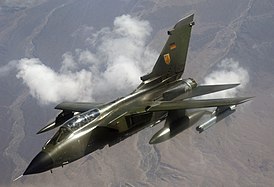
Panavia Tornado Fighter-Bomber
Panavia Tornado Fighter-Bomber
When the Tornados began to be put into service in 1979, no one expected that after 37 years they would continue to be used. Originally designed to fight a full-scale military conflict between NATO and the Warsaw Pact, they also found themselves in new conditions. Thanks to systematic modernization, Tornado fighter-bombers are still an important component of the armed forces of Great Britain, Italy and Germany.
In the mid-104s, work began on the creation of new combat jet aircraft in the European NATO countries. They have been undertaken in the UK (primarily in search of a successor to the Canberra tactical bombers), France (in need of a similar design), Germany, the Netherlands, Belgium, Italy and Canada (to replace the F-91G Starfighter and G-XNUMXG).
The UK, after canceling the program of tactical reconnaissance bombers TSR-2 of the British Aircraft Corporation (BAC) and refusing to purchase American F-111K machines, decided to establish cooperation with France. Thus was born the AFVG (English-French variable geometry) aircraft construction program - a joint British-French design (BAC-Dassault), which was to be equipped with variable geometry wings, have a take-off weight of 18 kg and carry 000 kg of combat aircraft, develop a maximum speed of 4000 km/h (Ma=1480) at low altitude and 1,2 km/h (Ma=2650) at high altitude and have a tactical range of 2,5 km. The BBM transmission was to consist of two gas turbine jet engines developed by the SNECMA-Bristol Siddeley consortium. Its users were to be naval aviation and the air forces of Great Britain and France.
The survey work that began on August 1, 1965 very quickly led to unsuccessful conclusions - calculations showed that such a design would be too large for the new French Foch aircraft carriers. In early 1966, the British Navy also dropped out of the group of future users, as a result of the decision to decommission classic aircraft carriers and focus on smaller units equipped with jet fighters and VTOL helicopters. . This, in turn, meant that after the purchase of the F-4 Phantom II fighters, the UK finally focused on the strike capabilities of the new design. In May 1966, the defense ministers of both countries presented the program schedule - according to them, the test flight of the BBVG prototype was to take place in 1968, and the delivery of production vehicles in 1974.
However, already in November 1966, it became clear that the power plant installed for the AFVG would be too weak. In addition, the entire project could be "eaten up" by the potentially high cost of development as a whole - this was especially important for France. Attempts to reduce the cost of developing the design were unsuccessful and on June 29, 1967, the French refused to cooperate on the aircraft. The reason for this step was also pressure from the unions of the French arms industry and the management of Dassault, which at that time was working on the Mirage G variable wing aircraft.
Under these conditions, the UK decided to continue the program on its own, giving it the designation UKVG (United Kingdom Variable Geometry), which then led to a more detailed consideration of FCA (Future Combat Aircraft) and ACA (Advanced Combat Aircraft).
The rest of the countries centered around Germany with the support of the American aviation industry. The result of this work was the NKF (Neuen Kampfflugzeug) project - a single-seat single-engine aircraft with a Pratt & Whitney TF30 engine.
At some point, a group looking for a successor to the F-104G Starfighter invited the UK to cooperate. A detailed analysis of the tactical and technical assumptions and the results of the work carried out led to the choice for further development of the NKF aircraft, which was supposed to be enlarged, and to be able to fight ground targets in any weather conditions, day and night. night. It was supposed to be a vehicle capable of penetrating the Warsaw Pact air defense system and operating in the depths of an enemy area, and not just a simple ground support aircraft on the battlefield.
Following this path, two countries - Belgium and Canada - withdrew from the project. The study was completed in July 1968, when it was planned to develop two options. The British needed a twin-engine, two-seat strike aircraft capable of using nuclear and conventional weapons. The Germans wanted a more versatile single-seat vehicle, also armed with AIM-7 Sparrow medium-range air-to-air guided missiles. Another compromise was needed to keep costs down. Thus, the MRCA (Multi-Role Combat Aircraft) construction program was launched.
